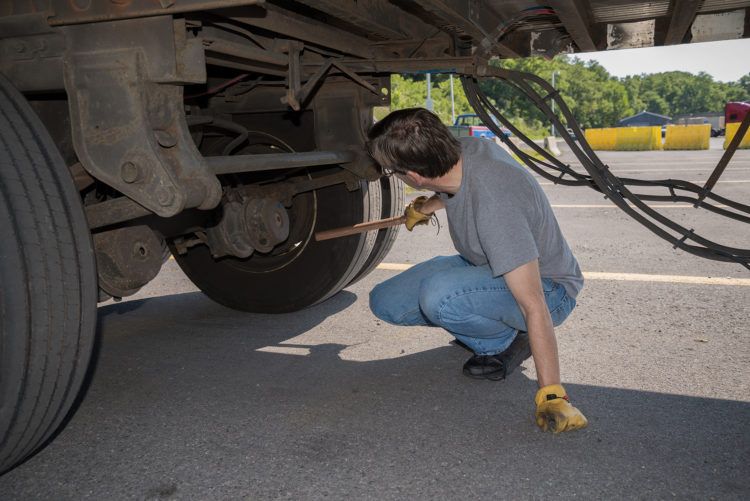Trucking 101: Maintaining Your Equipment

Find your next load
Make more money starting now.
A properly maintained truck is quite literally a money-making machine. As an owner-operator, your truck is your livelihood, and without it, you may not be able to support yourself and your business, so basic maintenance is a must. However, the most successful truckers go a step further, checking their truck’s mechanics as frequently as possible, making small adjustments and ensuring that their equipment is producing the most money per mile, every day.
Maintenance planning and truck upkeep can save an owner-operator thousands of dollars a year on fuel, tires, parts, and repairs. Further, preventative maintenance helps to keep your truck on the road, which is critical to business profitability.
Your truck’s maintenance manual will give you an idea of how often to perform certain tasks and will help you build a schedule. We’ve gathered the most critical preventative maintenance tasks to expect to complete or schedule to stay in tip-top shape.
Routine Wheel and Tire Maintenance
Maintaining your tires is one of the top ways to maximize your revenue per mile. Not only can your wheels and tires dramatically affect fuel efficiency, but their frequent replacement also eats into your bottom-line.
To reduce resistance, check air pressure on all 18 tires and fill them up at least weekly to the manufacturer’s specifications. Improper inflation is by far the greatest reason why tires fail or wear out prematurely.
Wheels naturally lose alignment and balance over time. If the wheels aren’t aligned correctly, tires aren’t rolling in a straight line, and wear will accelerate. As long as they don’t see unusual wear patterns or feathering, some owner-operators will have an alignment performed every 250,000 – 300,000 miles by default. Others plan an in-shop alignment check with every-other oil change and perform the alignment only if warranted. However, it’s generally agreed that if you notice uneven wear patterns, get it into the shop as soon as you can to mitigate damage.
Retreading is a standard method for extending the life of tires, and can be done as long as the tires are still in good condition aside from the tread wear. According to Tim Miller of Goodyear Tire and Rubber, tires can typically be retread 3-4 times in their lifetime.1
Tire rotation is another standard practice of tire maintenance and helps tires to wear more evenly. Typically, steer tires wear on the shoulders while drive tires wear in the center, etc. When you begin to see this pattern on your tires, it might be time to get rotated.
Chemicals and mud cause deterioration of tires, so it’s important to keep them just as clean as the cab of your truck. Don’t skip the inside dual tires, just because it’s harder to get to them.
After years of performing this type of maintenance, you will still get to the point where you should completely replace your tires. When you do need to bite the bullet and get new tires, it’s recommended that you take your rig to the shop with the old tires still on, so that the techs can read your tire wear and make adjustments that are custom to your truck.
You’ll also need to check axles and suspension components frequently, replacing any that show excessive wear. Change your shocks at least as often as your tires.
Oil Changes
The manufacturer of your engine will recommend the best interval for scheduling your oil changes. Many mechanics believe that the shorter the interval between oil changes, the longer your engine will last, and because oil changes are relatively inexpensive, it’s better to err on the side of ‘too often’ than ‘not enough.’
It’s generally accepted that trucks that idle overnight frequently, while not racking up additional miles, need more frequent oil changes. Many truckers will sample their oil often, since road conditions, temperature, and average speed can all affect the oil.
Grease Jobs
Grease jobs should occur more frequently than oil changes, and many truckers perform them themselves weekly or every-other-week. Some use the opportunity to get under the truck and look for problems that they may not have noticed from above.
Fuel Filter Replacements
Check your maintenance booklet for a recommendation, but typically, you’ll be changing your fuel filters about every-other oil change or around every 10,000 to 15,000 miles.
Checking for Compressor Leaks
If your air is low and won’t build back up at idle, you could have a leak. Get to know the pieces and parts of your air compressor, since many of them can be replaced for $5 or $10 by yourself.
Brake Checks
Make the 7-point brake inspection a key part of your pre-trip check, and recheck them each time you get a new load, at a minimum. Many truckers are certified brake inspectors and carry the tools and replacement parts to make adjustments if needed. Get to a repair shop if you sense problems on the road, and watch for roadside signs that call for a check.
Saving for Maintenance
A big part of preventative maintenance planning is saving funds for repairs. Many owner-operators set up a maintenance escrow savings account and drop funds into it based on the miles they run each month. Your truck warranty will cover some repairs, but not all. Plus, warranty or not, when your truck is in the shop it’s not making money, so you need a rainy day fund.
The following chart, from Team Run Smart2, suggest per-mile allotments for future maintenance and downtime, based on the age of your equipment.
| Age of Truck | Maintenance Savings |
| New | 5 cents per mile |
| 1 year old or 150,000 miles | 6 cents per mile |
| 2 years old or 300,000 miles | 7 cents per mile |
| 3 years old or 450,000 miles | 8 cents per mile |
| 4 years old or 600,000 miles | 10 cents per mile |
| 5+ years old or 750,000+ miles | 15 cents per mile |
- Worktruckonline.com, 2007
- Teamrunsmart.com, 2012
Get helpful content delivered to your inbox.
Sign up today.
Find high-quality loads fast, get higher rates on every haul, and access tools that make your job easier at every turn.






